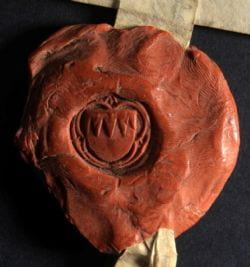CSI Medieval: researchers to uncover forensic secrets of Britain’s historic wax seals
5 January 2016
Modern forensic analysis will be paired with detailed historical research to reveal new insights into medieval British society hidden within the wax seals of thousands of historic documents. The unique research project, called Imprint, will examine fingerprints and palm prints left behind on the wax seals of documents dating from the 12th to the 14th […]

Modern forensic analysis will be paired with detailed historical research to reveal new insights into medieval British society hidden within the wax seals of thousands of historic documents.
The unique research project, called Imprint, will examine fingerprints and palm prints left behind on the wax seals of documents dating from the 12th to the 14th centuries. These seals, attached to documents such as land transactions, business contracts, and financial exchanges were the medieval equivalents of modern-day signatures and credit cards.
The three-year study is funded by the Arts and Humanities Research Council (AHRC) and led by Professor Philippa Hoskin from the University of Lincoln, UK, and co-investigator Dr Elizabeth New from Aberystwyth University. They will work with historical materials in the cathedrals of Exeter, Hereford and Lincoln, the National Library of Wales and Westminster Abbey.
The aim is to reveal more about medieval social structures, networks of authority, and the bureaucracies and protocols behind the authentication and security of documents in medieval England and Wales. The results will also help to answer questions about administrative and legal changes, including how the identification of the sealer with their seal changed over time – a practice known as the ‘performative act of sealing’.
Fingerprints retrieved during the archival research will be compared with modern prints stored on automated fingerprint identification systems (AFIS) to see if close matches can be found across such distant periods. This will contribute to understanding of the uniqueness of prints, advancing the science of hand mark identification.
That same analysis will also cross-reference all the medieval prints recorded by the project. This has the potential to solve medieval crimes of fraud – for example, if prints found on suspected forgeries can be identified with prints on genuine documents. Imprint’s forensic advisers, Forensic Focus, will present the data gathered at conferences and workshops for professional investigators.
Professor Hoskin, Professor of Medieval Studies at the University of Lincoln, said: “By the 12th century almost all administrative documents were sealed with wax, impressing a seal matrix to leave a distinctive impression. Some were bespoke and some bought off the shelf – but all were necessary to validate any legal document with which the seal’s owner was connected.
“These wax seals have the potential to give us so much information about medieval people, but they are often set aside as less important than the document itself. This will be the first time that the information the handprints found on those seals will be examined, and it could really offer historians new understanding of the period.
“The study will also contribute important information to current debates in forensics on the uniqueness of fingerprints, and not only that, but potentially uncover medieval crime.”
The prints will be collated into an online archive alongside detailed information about the seal impressions and documents. This resource will be made available to researchers, archivists, and the general public.
As the study progresses there will also be workshops for heritage professionals and specialist classes for students, to share knowledge with current curators and the next generation of those caring for sealed documents.
Example stories from the project’s work will be showcased through the website being developed by the Humanities Research Institute at University of Sheffield. There will also be workshops for members of the public, offering a vivid insight into medieval life.
Dr Elizabeth New, Senior Lecturer in Medieval History at Aberystwyth University, comments that: “Hand prints on wax seals bring us close to medieval people in a very tangible way. It is important to remember that seals were not just the preserve of kings and great nobles: men and women from all levels of society also set their seals on documents.
“Medieval seals contained a variety of images and words, providing strong statements of identity and very valuable sources of information about people, culture and society. The images can tell us what things actually looked like, and provide glimpses of humour, piety and family pride. They also enabled otherwise illiterate men and women the means to ‘write’ their name.
“These small objects have always had great significance, and are rich time-capsules that can open exciting windows into past lives. Examining the hand prints left – both accidentally and deliberately – in the wax along with impressions of seal matrices provides further important opportunities to deepen our understanding of our medieval ancestors.”
